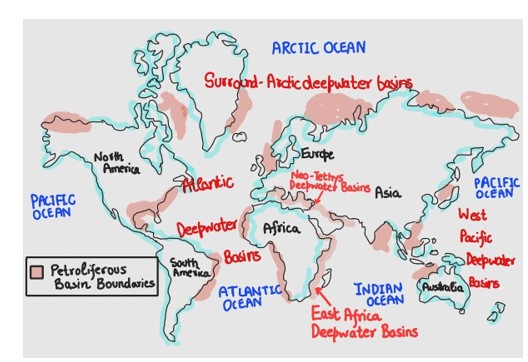UPSC CSE : 2025
Core Demand of the Question
|
Introduction
Oil reserves are formed in sedimentary basins where organic matter is trapped and transformed over geological time. Offshore oil reserves, found beneath continental shelves and oceanic basins, have emerged as key resources shaping the geography of global energy distribution.
Body

Geographical Explanation for the Distribution of Offshore Oil Reserves
Difference between Onshore and Offshore Oil Reserves
| Aspect | Off-shore Oil Reserves | On-shore Oil Reserves |
| Location | Found beneath continental shelves and deep-sea basins, formed by marine sedimentation. | Found in continental sedimentary basins and inland plains, often associated with folded mountains or basins. |
| Geological Setting | Linked to passive margins, rift basins, and deltaic deposits rich in marine organic matter.
Eg: North Sea, Gulf of Mexico. |
Associated with foreland basins, continental shelves, and interior basins.
Eg: Persian Gulf fields (Saudi Arabia, Iraq), Texas and Siberian plains. |
| Depth & Accessibility | Located in shallow to ultra-deep waters; extraction requires offshore rigs and subsea technology. | Occur at relatively shallower depths; accessible by land-based rigs and simpler infrastructure. |
| Cost of Exploration | Very high due to complex technology, offshore platforms, and safety measures. | Lower cost as drilling and transport infrastructure is easier and less risky on land. |
| Environmental Impact | Greater risk of oil spills, marine pollution, and ecological damage to coastal ecosystems. | Leads to land degradation, deforestation, and groundwater contamination. |
| Production Share | Contributes about 30% of global crude oil output, increasingly important due to deep-water discoveries. Eg: Brazil’s pre-salt fields, West Africa offshore. | Historically dominant, still supplies major share of global oil. Eg: On-shore fields in Middle East, Russia, USA. |
| Technological Dependence | Heavily reliant on R&D, subsea pipelines and remotely operated vehicles. | Less dependent on high-end technology. Conventional drilling methods often suffice. |
Conclusion
The distribution of offshore oil reserves underlines geography’s role in global energy supply. While these reserves are crucial for energy security, their exploitation must be balanced with ecological safeguards and a gradual shift towards offshore wind and other renewables for a sustainable energy future.
<div class="new-fform">
</div>